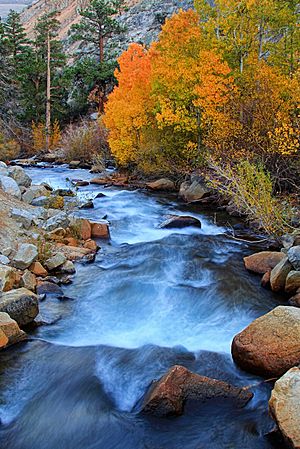Battle of Bishop Creek facts for kids
The Battle of Bishop Creek was an important fight during the Owens Valley Indian War. It happened on April 6, 1862, near Bishop Creek in what is now Inyo County, California.
In 1861, people started bringing cattle over the Sierra Nevada Mountains. They were feeding miners in a busy town called Aurora. Some ranchers also began raising cattle in the nearby Owens Valley.
A very bad winter in 1862, known as the Great Flood of 1862, made things difficult. The cattle were eating food that the local Owens Valley Paiute people needed. This meant the Paiute faced starvation. To survive, they had to take some of the cattle. This led to many arguments and fights with the ranchers.
Both sides tried to make peace, but it didn't last. Soon, the arguments turned into a full-scale war, which became known as the Owens Valley Indian War.
Contents
Why Did the Battle Happen?
The conflict started because settlers brought many cattle into the Owens Valley. These cattle ate plants that the native Paiute people relied on for food. After a very harsh winter, the Paiute faced starvation. They began taking cattle to feed their families. This led to fights with the ranchers.
Who Fought in the Battle?
When the conflict grew, settlers gathered their cattle about 30 miles (48 km) north of Owens Lake. This was at the meadows near Oak Creek. They sent messages asking for help. They reached out to Aurora, which was the main town in nearby Mono County. They also asked for help from Visalia, the main town in their own Tulare County.
William Mayfield led a group of soldiers from Tulare County to help the settlers. John J. Kellogg, a former Army captain, brought 18 men from Aurora to join them.
The Battle of Bishop Creek
After the soldiers arrived, they joined forces with the local settlers. Colonel William Mayfield was in charge of this combined group. He led about 60 men on a march 50 miles (80 km) north up the valley. This march began on March 28, 1862.
On April 6, 1862, Colonel Mayfield's group met the Paiute people at Bishop Creek. A fierce battle began. Mayfield's men attacked, but they were pushed back. They had to hide in a ditch and stay there until nightfall. When it got dark, they were able to leave, taking their dead and wounded with them. They then headed back down the valley.
One report from that time said:
- "Around noon on April 6, there was a very strong fight. C. J. Pleasants from Aurora, Mr. Morrison from Visalia, and Sheriff Scott from Mono county were killed. The white men took shelter in an irrigation ditch. From there, they fired, causing some damage. At night, after the moon went down, the Indians stopped firing. The white men then left, leaving behind about seventeen or eighteen of their horses, and a lot of ammunition and supplies."
The next day, April 7, 1862, Colonel Mayfield's group met another group of soldiers. These were California Volunteer forces led by George S. Evans. Colonel Mayfield and about 40 of his men joined Colonel Evans. They continued heading north. The injured men and the rest of Mayfield's group returned to Oak Creek.
California Historical Landmark
The site of the Battle of Bishop Creek is now a California Historical Landmark. It is number 811.
The sign at the landmark says:
- NO. 811 BISHOP CREEK BATTLEGROUND - On April 6, 1862, a battle took place around this site between newly arrived citizens of the Owens River Valley and the original inhabitants of the land, the Paiute and Shoshone Indians. The reason for this battle is lost but brave men on both sides died here for a cause which they held inviolate.


